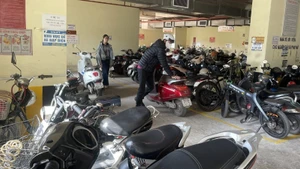Appropriate implementation timeline
Traffic safety experts said safety seats for children in cars will help reduce the risk of injuries for the country’s future generations.
Colonel Nguyen Quang Nhat, at the Traffic Police Department under the Ministry of Public Security (MPS), reported that traffic safety in the first ten months of 2024 was extremely complex, with accident fatalities reaching nearly 9,000 people.
In a draft decree on administrative penalties for traffic order and safety violations, the MPS proposes a fine ranging from 800,000 to 1 million VND, along with driving license point deductions for car drivers who violate regulations by having children under 10 years old and under 1.35m in height sitting in the same row as the driver or not using appropriate child restraint systems, except for cars with only one row of seats.
Dr Tran Huu Minh, Chief of Office of the National Traffic Safety Committee, stated, “The cost for a child safety seat ranges from 3-15 million VND. Compared to owning a car, this safety equipment’s cost only accounts for about 0.3-0.4% of the value of a new car. This is an amount that most car owners can afford.”
However, Minh also noted that implementation should first focus on private passenger cars, as these vehicles can travel at maximum speeds of 120 kilometres per hour on expressways, have a high frequency of child usage, and parents or guardians can always anticipate this need in advance.
Regarding public transport and commercial transport vehicles, the official suggested that initially, these regulations should be encouraged for long-range public transport vehicles to allow preparation time, as these vehicles operate at lower speeds in urban areas, have higher safety standards, and face difficulties in meeting random needs for child transport.
“We can regulate that vehicles transporting kindergarten and primary school students must have specialised safety belts designed appropriately for these age groups,” Minh suggested.
Legal gaps
Luong The Khanh, Vice Chairman of the Vietnam Children’s Rights Protection Association, observed that the first requirement is parent awareness to ensure children’s car safety. Besides communication, functional forces need to develop penalty mechanisms and strictly implement them for these regulations to be effective in real life. Enforcement must be as strict as with drunk driving violations, which will help protect Vietnam’s future generations.
Duong Kim Tuan, Deputy Director of the Centre for Policy Research and Injury Prevention at the University of Public Health, assessed that car usage in our country is rapidly increasing, and ensuring children’s safety when travelling by car is an issue that needs attention.
“Research data from three cities - Hanoi, Da Nang and Ho Chi Minh City - shows that, on average, only 1.3% of car owners use child safety seats. Therefore, children should not sit in the front seat as they would face greater impact during accidents and collisions, could easily be ejected from the vehicle, and be directly affected by airbag deployment. Additionally, children are typically active and curious, which distracts the driver. And in terms of design, cars usually don’t have child restraint systems installed in the front row,” said Tuan.
Currently, nearly 100 countries worldwide have mandated the use of child restraint systems. However, this issue has not received adequate attention in Vietnam, and the use of seatbelts and safety seats for children in cars has not been emphasised in practice. As a result, children’s safety in cars has not been properly ensured during transport, leading to many unfortunate accidents affecting children’s health and lives.
Commenting on concerns about whether using just a seatbelt without a safety seat in cars is safe enough, Tuan stated that this would not provide the best protection for children due to factors related to sitting contact points, weight, and height of children. Meanwhile, car safety devices for children are designed to be compatible with children’s size and weight.
According to World Health Organisation (WHO) recommendations, only children aged 12 and above with a height of 1.5m or taller should use standard seatbelts. If child safety seats are used in cars, it is entirely possible to limit unfortunate risks during collisions or incidents while the vehicle is in motion.
To enforce this regulation, Tuan noted that functional agencies need to promote awareness about the importance of child restraint systems, provide financial support programmes, discounts, or loans to help families purchase these devices, inspect and penalise violations, monitor and evaluate the implemented measures and adjust them if necessary.
















